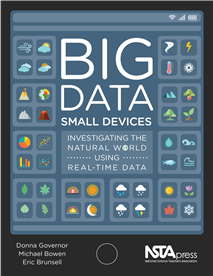Big Data, Small Devices: Investigating the Natural World Using Real-Time Data
By Carole Hayward
Posted on 2017-02-01
 Many students nowadays are dependent on electronic devices. In fact, it’s sometimes hard to separate them from their smartphones and tablets. As Donna Governor, Michael Bowen, and Eric Brunsell—the authors of Big Data, Small Devices—point out, “Today’s students see technology as an integral part of their world and find technology solutions for almost every need.”
Many students nowadays are dependent on electronic devices. In fact, it’s sometimes hard to separate them from their smartphones and tablets. As Donna Governor, Michael Bowen, and Eric Brunsell—the authors of Big Data, Small Devices—point out, “Today’s students see technology as an integral part of their world and find technology solutions for almost every need.”
It seems like a natural fit, then, to use these same devices for meaningful instruction. But it’s not always easy to turn digital devices into valuable learning tools. That’s why Big Data, Small Devices is such a helpful resource for science teachers who want to use smartphone and tablet apps that provide “real-time” data to explore Earth and environmental science concepts.
The authors point to several sites that provide real-time data (stream quality, groundwater levels, toxic waste amounts, sunrise and sunset times, earthquakes, and so on) collected by various government agencies. The data are free of cost and available as a public service. The book provides sample activities that use smartphones and tables for more than two dozen investigations using the real-time data. Each activity has a student handout, technology notes that provide appropriate websites and apps, and analysis and reflection questions.
As you can see from this sample chapter, each activity also provides teacher notes that include information on learning goals, disciplinary core ideas, science and engineering practices, crosscutting concepts, and background information. Investigations are organized into groups that focus on using real-time atmosphere data, geosphere data, biosphere data, hydrosphere data, and celestial sphere data.
In addition to providing specific activities, the book offers an excellent overview for how real-time data can be used for Earth and environmental science investigations. The authors do a great job at providing tips and tricks for accessing the technology and for how real-time data can be used to help students develop a deeper understanding of scientific concepts.
With the help of this book, students can engage in the higher-order thinking that comes with analyzing and interpreting data. And, as the authors state in their book, “Allowing students to conduct investigations using their smartphone in app-based activities allows them to be more engaged in science investigations.”
This book is also available as an e-book.
Follow NSTA
Save
Disclaimer: The views expressed in this blog post are those of the author(s) and do not necessarily reflect the official position of the National Science Teaching Association (NSTA).


